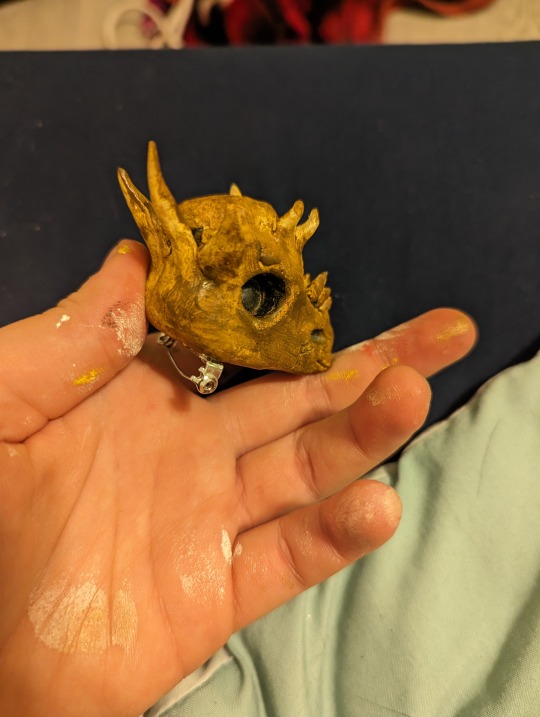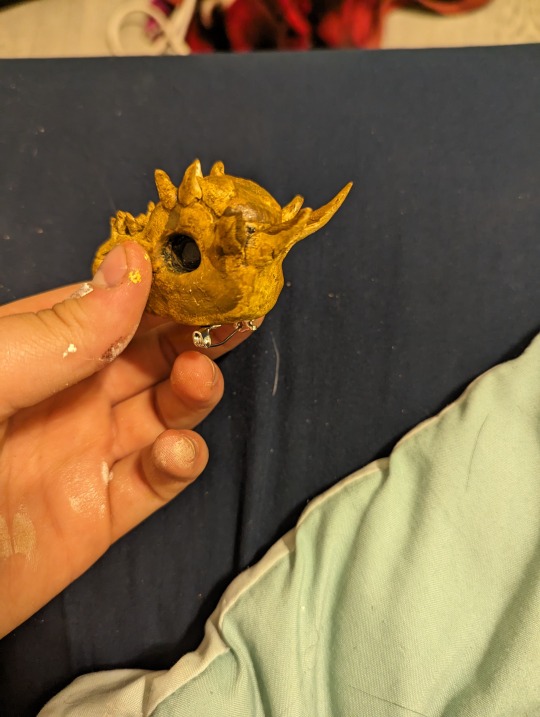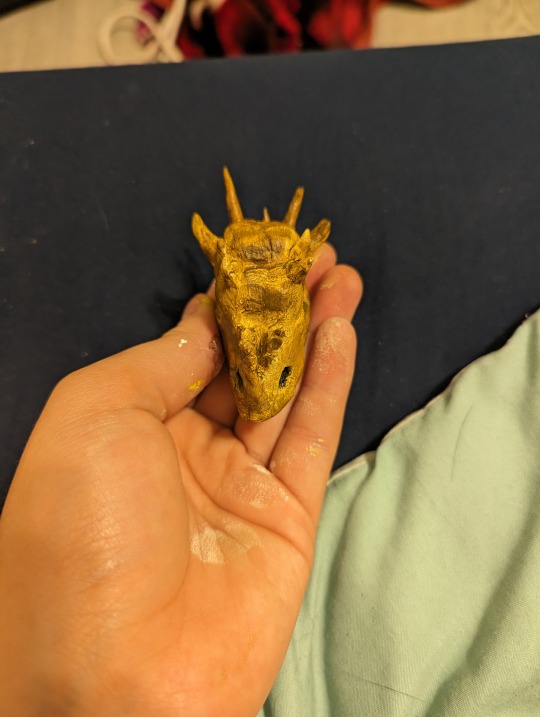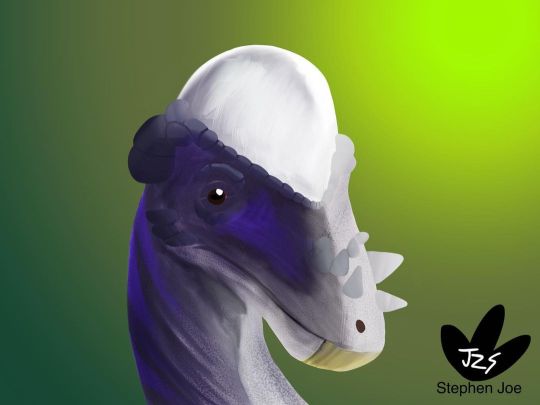#P. Wyomingensis
Text
A pachycephalosaurus skull pin that I sculpted





Fun fact: did you know that because of the amount of iron that is in the dirt where fossils are, fossils are actually a rusty brown color! Another fun fact: some paleontologists believe that the Stygimoloch might be a juvenile of the Pachycephalosaurus Wyomingensis. There are some theories that the other pachycephalosaurid, the Dracorex hogwartsia (which means "dragon king of Hogwarts") might be a female specimen of the P. Wyomingensis, but that's just speculation.
#P. Wyomingensis#Pachycephalosaurus#Stygimoloch#Dracorex hogwartsia#Dinosaurs#palentology#Fossils#Pins#Brooches#paleoart#paleoblr
38 notes
·
View notes
Photo

Day 25: Pachycephalosaurus Pachycephalosaurus wyomingensis is a last non-avian pachycephalosaurid, along with small relatives of Sphaerotholus. #Dinovember #Dinovember2022 #paleoart #sketchbookapp #myart #pachycephalosaurus #pachycephalosauruswyomingensis #pachycephalosauridae #pachycephalosauria #marginocephalia #ornithischia #dinosauria #dinosaur https://www.instagram.com/p/ClZp5Q_rXg5/?igshid=NGJjMDIxMWI=
#dinovember#dinovember2022#paleoart#sketchbookapp#myart#pachycephalosaurus#pachycephalosauruswyomingensis#pachycephalosauridae#pachycephalosauria#marginocephalia#ornithischia#dinosauria#dinosaur
24 notes
·
View notes
Text
On a roll today, gonna tell you about one of my favourite dinosaurs and the reason why: Pachycephalosaurus wyomingensis!
Most people with even a passing knowledge of dinosaurs know that pachycephalosaurids are amongst the coolest dinos, but what makes P. wyomingensis so great to me is its name, which directly translates into "thickheaded beast from Wyoming"
THICKHEADED BEAST FROM WYOMING!!!!
It brings me so much joy to know that there is a dinosaur essentially named the "ugly dumbass from fucking Wyoming" because my god that is funny.
2 notes
·
View notes
Text
Plesiocathartes insolitipes Mayr & Kitchener, 2022 (new species)

(Type specimen of Plesiocathartes insolitipes [scale bar = 10 mm], from Mayr and Kitchener, 2022)
Meaning of name: insolitipes = unusual foot [in Latin]
Age: Eocene (Ypresian), 54.6‒55 million years ago
Where found: London Clay Formation, Essex, U.K.
How much is known: Two partial skeletons, including a partial skull, several vertebrae, and various limb bones.
Notes: P. insolitipes was closely related to the extant courol (Leptosomus discolor), a tree-dwelling bird from Madagascar and the Comoros. Despite its restricted distribution today, the courol had close relatives that ranged widely during the Paleogene. Previously named species of the Eocene genus Plesiocathartes include P. europaeus from France, P. geiselensis and P. kelleri from Germany, and P. major and P. wyomingensis from the United States.
P. insolitipes was generally similar to the courol in its skeletal anatomy, but had a differently shaped wishbone and unusually wide, club-like tips of the bones in the outermost two toes of each foot. The latter trait aso distinguishes it from other species of Plesiocathartes for which these bones are known.
Reference: Mayr, G. and A.C. Kitchener. 2022. New species from the early Eocene London Clay suggest an undetected early Eocene diversity of the Leptosomiformes, an avian clade that includes a living fossil from Madagascar. Palaeobiodiversity and Palaeoenvironments advance online publication. doi: 10.1007/s12549-022-00560-0
18 notes
·
View notes
Video
whydinosaurs
Pachycephalosaurus means "thick head lizard". It was a bipedal herbivore. P. wyomingensis is the only known species of this genus. This one is from South Dakota and is from the Late Cretaceous.
#pachycephalosaurus#fossil#fossils#dinosaur#fossilfriday#royal tyrrell museum#geology#paleontology#video#instagram#the earth story
432 notes
·
View notes
Photo

Is a genus of pachycephalosaurid dinosaurs. The type species, P. wyomingensis, is the only known species. It lived during the Late Cretaceous Period (Maastrichtian stage) of what is now North America. Remains have been excavated in Montana, South Dakota, Wyoming and Alberta. It was a herbivorous creature which is primarily known from a single skull and a few extremely thick skull roofs, at 9 inches thick. More complete fossils have been found in recent years. Pachycephalosaurus was one of the last non-avian dinosaurs before the Cretaceous–Paleogene extinction event. Another dinosaur, Tylosteus of western North America, has been synonymized with Pachycephalosaurus, as have the genera Stygimoloch and Dracorex in recent studies. Like other pachycephalosaurids, Pachycephalosaurus was a bipedal herbivore with an extremely thick skull roof. It possessed long hindlimbs and small forelimbs. Pachycephalosaurus is the largest-known pachycephalosaur. The thick skull domes of Pachycephalosaurus and related genera gave rise to the hypothesis that pachycephalosaurs used their skulls in intra-species combat. This hypothesis has been disputed in recent years.
Herbivore
Pachycephalosaurus (c) Jurassic Park
Art (c) reneg661
3 notes
·
View notes
Photo

Pachycephalosaurus wyomingensis skull at the Raymond M. Alf Museum of Paleontology.
Pachycephalosaurus is a genus of Pachycephalosaurine Ornithischian dinosaur. It lived during the late Cretaceous of North America, alongside some of the most iconic dinosaurs such as Tyrannosaurus and Triceratops. It is known from only one species, P. wyomingensis, the adults of which are only known from skull remains.
Pachycephalosaurus is famous for having drastic ontogenetic stages (meaning babies looked different from adults), so much so that two of its juvenile forms were originally assigned to different genera; Dracorex and Stygimoloch.
175 notes
·
View notes
Text
Plesiocathartes europaeus, P. geiselensis, P. kelleri, P. gaillardi, P. wyomingensis

By Jack Wood on @thewoodparable
PLEASE SUPPORT US ON PATREON. EACH and EVERY DONATION helps to keep this blog running! Any amount, even ONE DOLLAR is APPRECIATED! IF YOU ENJOY THIS CONTENT, please CONSIDER DONATING!
Name: Plesiocathartes europaeus, P. geiselensis, P. kelleri, P. gaillardi, P. wyomingensis
Status: Extinct
First Described: 1908
Described By: Gaillard
Classification: Dinosauria, Theropoda, Neotheropoda, Averostra, Tetanurae, Orionides, Avetheropoda, Coelurosauria, Tyrannoraptora, Maniraptoriformes, Maniraptora, Pennaraptora, Paraves, Eumaniraptora, Averaptora, Avialae, Euavialae, Avebrevicauda, Pygostylia, Ornithothoraces, Euornithes, Ornithuromorpha, Ornithurae, Neornithes, Neognathae, Neoaves, Inopinaves, Telluraves, Afroaves, Coraciimorphae, Eucavitates, Leptosomatiformes
Plesiocathartes is an extinct type of bird that was originally thought to be a New World Vulture (hence the name, which includes cathartes), but then was actually found in later studies to be, possibly, related to the Cuckoo Roller - a bird that, much like the Hoatzin, is extremely unique, extremely rare, and phylogenetically mysterious. So, finding an extinct relative of the Cuckoo Roller is quite important to better understand where this particular rare dinosaur came from (the classification line above is based on recent DNA studies that are still somewhat controversial). It is known from the Quercy Fissure of France, the Geisel Valley of Germany, the Messel Pit of Germany, and the Green River Formation, and another species is known from the London Clay Formation as well, so while it is a primarily European sort of bird, it did spread to America as well. It lived from the Eocene to the Oligocene epochs of the Paleogene, from about 37 to 28 million years ago, in the Bartonian to Rupelian ages. So not only was it widespread, it was also long lived. Even back at that point, they looked extremely like the modern Cuckoo Roller, except for that its wishbone was smaller and more U-shaped, and it also had longer legs. Apart from that, it seems that the Cuckoo Rollers in general went extinct in the early Oligocene in the Northern Hemisphere.
Sources:
Mayr, G. 2009. Paleogene Fossil Birds. Springer-Verlag Berlin Heidelberg.
http://fossilworks.org/bridge.pl?a=taxonInfo&taxon_no=39650
#plesiocathartes#cuckoo roller#bird#dinosaur#birblr#palaeoblr#plesiocathartes europaeus#plesiocathertes geiselensis#plesiocathartes kelleri#plesiocathartes gaillardi#plesiocathartes wyomingensis#paleontology#prehistory#prehistoric life#dinosaurs#biology#a dinosaur a day#a-dinosaur-a-day#dinosaur of the day#dinosaur-of-the-day#science#nature#factfile#Dìneasar#דינוזאור#डायनासोर#ديناصور#ডাইনোসর#risaeðla#ڈایناسور
36 notes
·
View notes
